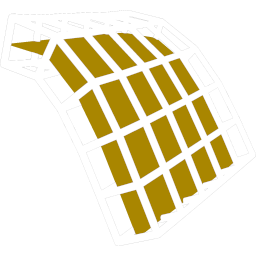
Carbon Mesh Deformer¶
Description¶
Utility node to deform geometry based on another geometry. This is similar to the built-in Houdini Cloth Capture + Cloth Deform SOP nodes.
Inputs¶
Input #1 - Driver
Mesh representing the driver geometry.
Driver is the mesh that deforms the Geometry. In most cases, this will be a Carbon Cloth output mesh.
Note
If Driver Reference is not provided, the Driver mesh needs to be in Geometry space.
Input #2 - Geometry
Mesh to be deformed by the Driver.
Note
Needs to be in the same space as Driver Reference, or Driver if Driver Reference is not provided.
Input #3 - Driver Reference
Optional parameter.
Driver mesh in reference space, i.e. in space of Geometry.
This follows a similar notion to Carbon Cloth Start and Reference meshes.
Note
- Driver reference must be in the same space as Geometry and is an optional parameter.
- If Driver Reference is not provided, the Driver mesh needs to be in Geometry space.
Parameters¶
Auto Update while mapping invalid autoUpdate
Tick this box to automatically update the mapping, if no valid mapping can be found.
Mapping From File¶
Auto Export new Mapping autoExport
Tick this box to automatically export newly generated mappings to file.
File Path filePath
File path to the nmrb file that mappings are loaded from, or saved to.
Import
Click to load mapping from file specified in File Path.
Export
Click to save mapping to file specified in File Path.
New Mapping¶
Deformer Type
There are 3 deformer types available:
- Skinning:
- The most stable, and default deformer. This relies on the 4 closest triangles of the Driver mesh for each point of the Geometry mesh. This is fully procedural and does not rely on any user radius or scale.
- Strengths:
- Fast, robust, relatively low in terms of memory usage.
- Does not depart from the simulation mesh silhouette. This means that it does not induce artificial motion or (self) intersections, assuming that the Geometry mesh did fit in the fat surface of the (Cloth) simulated Driver mesh.
- Weaknesses:
- The smoothness of the skinning deformer result depends on the resolutions of both Driver and Geometry meshes.
- Fails on Driver geometry with (near) zero sized primitives. This will lead to visual spikes in the deformer results.
- Analytical:
- Generates an infinitely smooth result without departing from the collision cage of the Driver mesh. It relies on an analytical equation for the positions instead of a convolution or a blend. This is fully procedural and does not rely on any user radius or scale.
- Strengths:
- Lowest memory usage of all deformer types.
- The smoothness of the analytical deformer result is only dependent on the Driver mesh and is not affected by the Geometry mesh resolution.
- Does not depart from the simulation mesh silhouette. This means that it does not induce artificial motion or (self) intersections, assuming that the Geometry mesh did fit in the fat surface of the (Cloth) simulated Driver mesh.
- This deformer is generally best at producing smooth results from physical simulations but it needs a lot more care in the mapping process.
- Weaknesses:
- Singularities in the Driver mesh, i.e. concave regions where the closest Driver triangle is uncertain.
- It is not yet augmented to bind points of Geometry’s mesh beyond the open edges of the Driver’s mesh and can fail in areas where the Driver mesh has tangent discontinuities.
- Smoothing:
- Relies on brute force smoothing kernels to combine the motion of multiple Driver primitives to update each point of the Geometry. This is an adapted version of the Skinning Deformer where each Geometry point can be mapped to more than 4 Driver primitives, all depending on the Radius. While this tackles the Skinning deformer’s weakness, i.e. smoothness, it compromises its strengths, i.e. memory usage and Driver silhouette preservation.
- Strengths:
- Weaknesses:
- Its memory usage and bandwidth are large compared to the Skinning and Analytical deformers.
- Relies on setting the best kernel Radius in order to achieve the best smoothness without departing (too much) from the simulated silhouette. It is important to understand that while the Skinning and Analytical deformers strictly conform to the Driver points, meaning perfect preservation of the Driver silhouette, the Smoothing deformer can deviate from this to reach smooth results. This can induce non-physical motion blurred by the convolution product and big collision violations and interpenetrations from surfaces that did not fail the simulation in the first place. Finding the right kernel Radius for your needs is imperative. This is why we added an Estimate Radius button that uses an algorithm to estimate the best Radius to achieve a balance between smoothness of the deformer results and preservation of the Driver silhouette.
- Fails on Driver geometry with (near) zero sized primitives. This will lead to visual spikes in the deformer results.
Radius radius
Smoothing deformer kernel radius.
Note
This parameter is only accessible when using the Smoothing deformer type.
Estimate radius
Press this button to receive an estimate of the best Radius to achieve a balance between smoothness of the deformer results and preservation of the Driver silhouette.
Note
This parameter is only accessible when using the Smoothing deformer type.
Apply Estimate
Press this button to apply the Estimated Radius to Radius
Note
This parameter is only accessible when using the Smoothing deformer type.
Update Mapping
Press this button to manually update the mapping.
Status¶
Status
Status updates.
